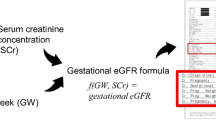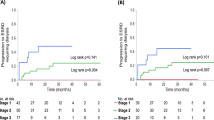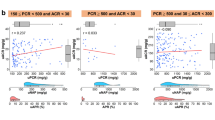Abstract
Objective: To compare the urine protein–creatinine ratio with urinalysis to predict significant proteinuria (⩾300 mg per day).
Study Design: A total of 116 paired spot urine samples and 24-h urine collections were obtained prospectively from women at risk for preeclampsia. Urine protein–creatinine ratio and urinalysis were compared to the 24-h urine collection.
Result: The urine protein–creatinine ratio had better discriminatory power than urinalysis: the receiver operating characteristic curve had a greater area under the curve, 0.89 (95% confidence interval (CI) 0.83 to 0.95) vs 0.71 (95% CI 0.64 to 0.77, P<0.001). When matched for clinically relevant specificity, urine protein–creatinine ratio (cutoff ⩾0.28) is more sensitive than urinalysis (cutoff ⩾1+): 66 vs 41%, P=0.001 (with 95 and 100% specificity, respectively). Furthermore, the urine protein–creatinine ratio predicted the absence or presence of proteinuria in 64% of patients; urinalysis predicted this in only 19%.
Conclusion: The urine protein–creatinine ratio is a better screening test. It provides early information for more patients.
This is a preview of subscription content, access via your institution
Access options
Subscribe to this journal
Receive 12 print issues and online access
$259.00 per year
only $21.58 per issue
Buy this article
- Purchase on Springer Link
- Instant access to full article PDF
Prices may be subject to local taxes which are calculated during checkout


Similar content being viewed by others
References
ACOG Committee on Obstetric Practice. ACOG practice bulletin. Diagnosis and management of preeclampsia and eclampsia. Number 33, January 2002. American College of Obstetricians and Gynecologists. Int J Gynaecol Obstet 2002; 77: 67–75.
Meyer NL, Mercer BM, Friedman SA, Sibai BM . Urinary dipstick protein: a poor predictor of absent or severe proteinuria. Am J Obstet Gynecol 1994; 170: 137–141.
Waugh JJ, Clark TJ, Divakaran TG, Khan KS, Kilby MD . Accuracy of urinalysis dipstick techniques in predicting significant proteinuria in pregnancy. Obstet Gynecol 2004; 103: 769–777.
Kuo VS, Koumantakis G, Gallery ED . Proteinuria and its assessment in normal and hypertensive pregnancy. Am J Obstet Gynecol 1992; 167: 723–728.
Brown MA, Buddle ML . Inadequacy of dipstick proteinuria in hypertensive pregnancy. Aust N Z J Obstet Gynaecol 1995; 35: 366–369.
Saudan PJ, Brown MA, Farrell T, Shaw L . Improved methods of assessing proteinuria in hypertensive pregnancy. Br J Obstet Gynaecol 1997; 104: 1159–1164.
Rodriguez-Thompson D, Lieberman ES . Use of a random urinary protein-to-creatinine ratio for the diagnosis of significant proteinuria during pregnancy. Am J Obstet Gynecol 2001; 185: 808–811.
Young RA, Buchanan RJ, Kinch RA . Use of the protein/creatinine ratio of a single voided urine specimen in the evaluation of suspected pregnancy-induced hypertension. J Fam Pract 1996; 42: 385–389.
Al RA, Baykal C, Karacay O, Geyik PO, Altun S, Dolen I . Random urine protein–creatinine ratio to predict proteinuria in new-onset mild hypertension in late pregnancy. Obstet Gynecol 2004; 104: 367–371.
Robert M, Sepandj F, Liston RM, Dooley KC . Random protein–creatinine ratio for the quantitation of proteinuria in pregnancy. Obstet Gynecol 1997; 90: 893–895.
Neithardt AB, Dooley SL, Borensztajn J . Prediction of 24-h protein excretion in pregnancy with a single voided urine protein-to-creatinine ratio. Am J Obstet Gynecol 2002; 186: 883–886.
Quadri KH, Bernardini J, Greenberg A, Laifer S, Syed A, Holley JL . Assessment of renal function during pregnancy using a random urine protein to creatinine ratio and Cockcroft–Gault formula. Am J Kidney Dis 1994; 24: 416–420.
Durnwald C, Mercer B . A prospective comparison of total protein/creatinine ratio versus 24-h urine protein in women with suspected preeclampsia. Am J Obstet Gynecol 2003; 189: 848–852.
Clark LC, Thompson H, Beck EI . The excretion of creatine and creatinine during pregnancy. Am J Obstet Gynecol 1951; 62: 576–583.
Brown MA, Lindheimer MD, de Swiet M, Van Assche A, Moutquin JM . The classification and diagnosis of the hypertensive disorders of pregnancy: statement from the International Society for the Study of Hypertension in Pregnancy (ISSHP). Hypertens Pregnancy 2001; 20: IX–XIV.
Altman DG, Bland JM . Diagnostic tests 1: sensitivity and specificity. BMJ 1994; 308: 1552.
Altman DG, Bland JM . Diagnostic tests 2: predictive values. BMJ 1994; 309: 102.
Simel DL, Samsa GP, Matchar DB . Likelihood ratios with confidence: sample size estimation for diagnostic test studies. J Clin Epidemiol 1991; 44: 763–770.
DeLong ER, DeLong DM, Clarke-Pearson DL . Comparing the areas under two or more correlated receiver operating characteristic curves: a nonparametric approach. Biometrics 1988; 44: 837–845.
Jaeschke R, Guyatt G, Sackett DL . Users’ guides to the medical literature. III. How to use an article about a diagnostic test. A. Are the results of the study valid? Evidence-based Medicine Working Group. JAMA 1994; 271: 389–391.
Mattix HJ, Hsu CY, Shaykevich S, Curhan G . Use of the albumin/creatinine ratio to detect microalbuminuria: implications of sex and race. J Am Soc Nephrol 2002; 13: 1034–1039.
Acknowledgements
This study was financially supported by the Department of Gynecology and Obstetrics, Stanford University.
Author information
Authors and Affiliations
Corresponding author
Rights and permissions
About this article
Cite this article
Dwyer, B., Gorman, M., Carroll, I. et al. Urinalysis vs urine protein–creatinine ratio to predict significant proteinuria in pregnancy. J Perinatol 28, 461–467 (2008). https://doi.org/10.1038/jp.2008.4
Received:
Revised:
Accepted:
Published:
Issue Date:
DOI: https://doi.org/10.1038/jp.2008.4
Keywords
This article is cited by
-
Urinary strips for protein assays: easy to do but difficult to interpret!
Journal of Nephrology (2021)
-
Diagnostic accuracy of random urinary protein-to-creatinine ratio for proteinuria in patients with suspected pre-eclampsia
Archives of Gynecology and Obstetrics (2021)
-
Periodic urinary protein creatinine ratio for predicting significant proteinuria in preeclampsia in different alternatives: time effectiveness analysis
Archives of Gynecology and Obstetrics (2010)
-
Predicting proteinuria in pregnancy: a potential algorithm
Journal of Perinatology (2008)



